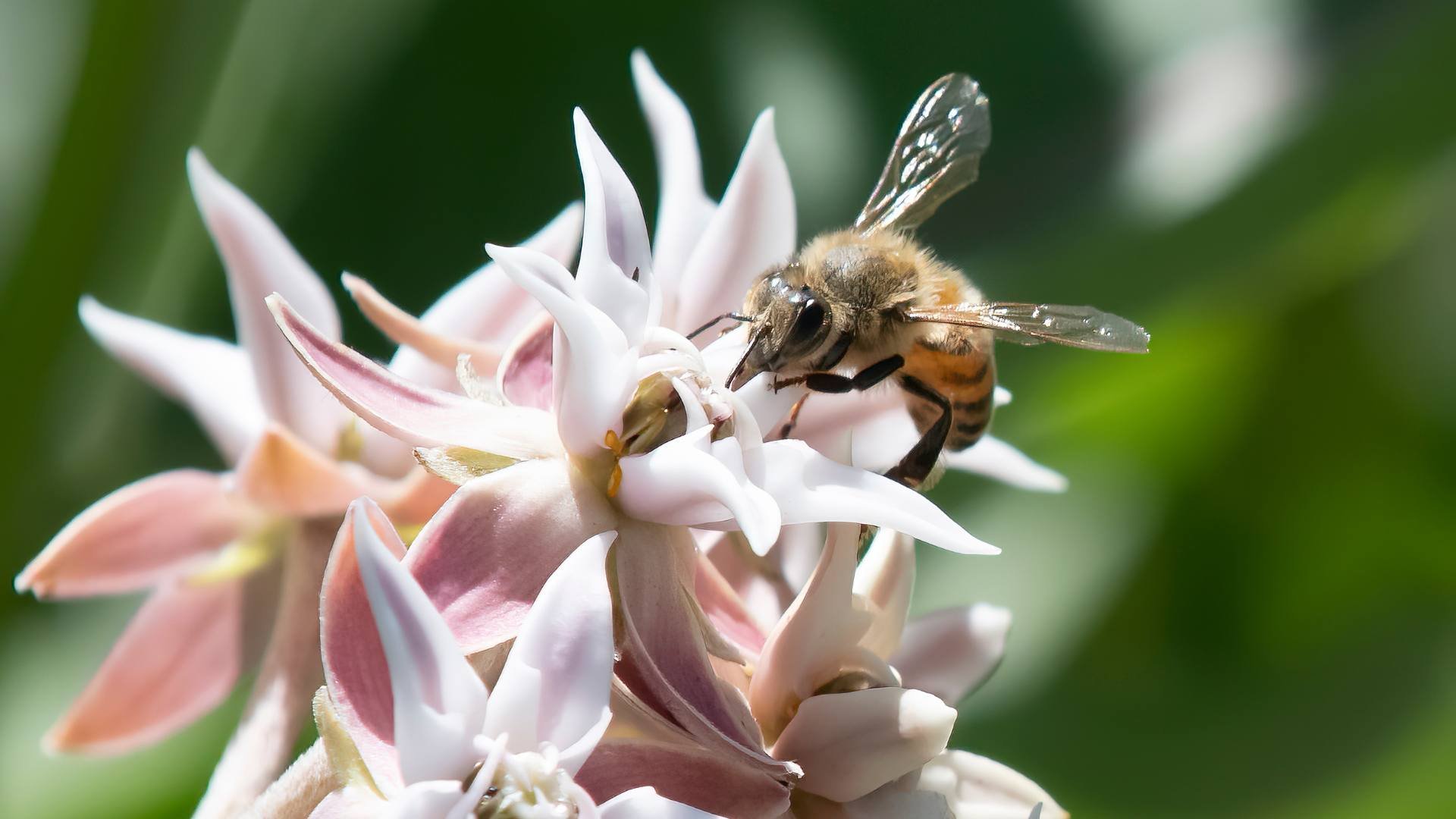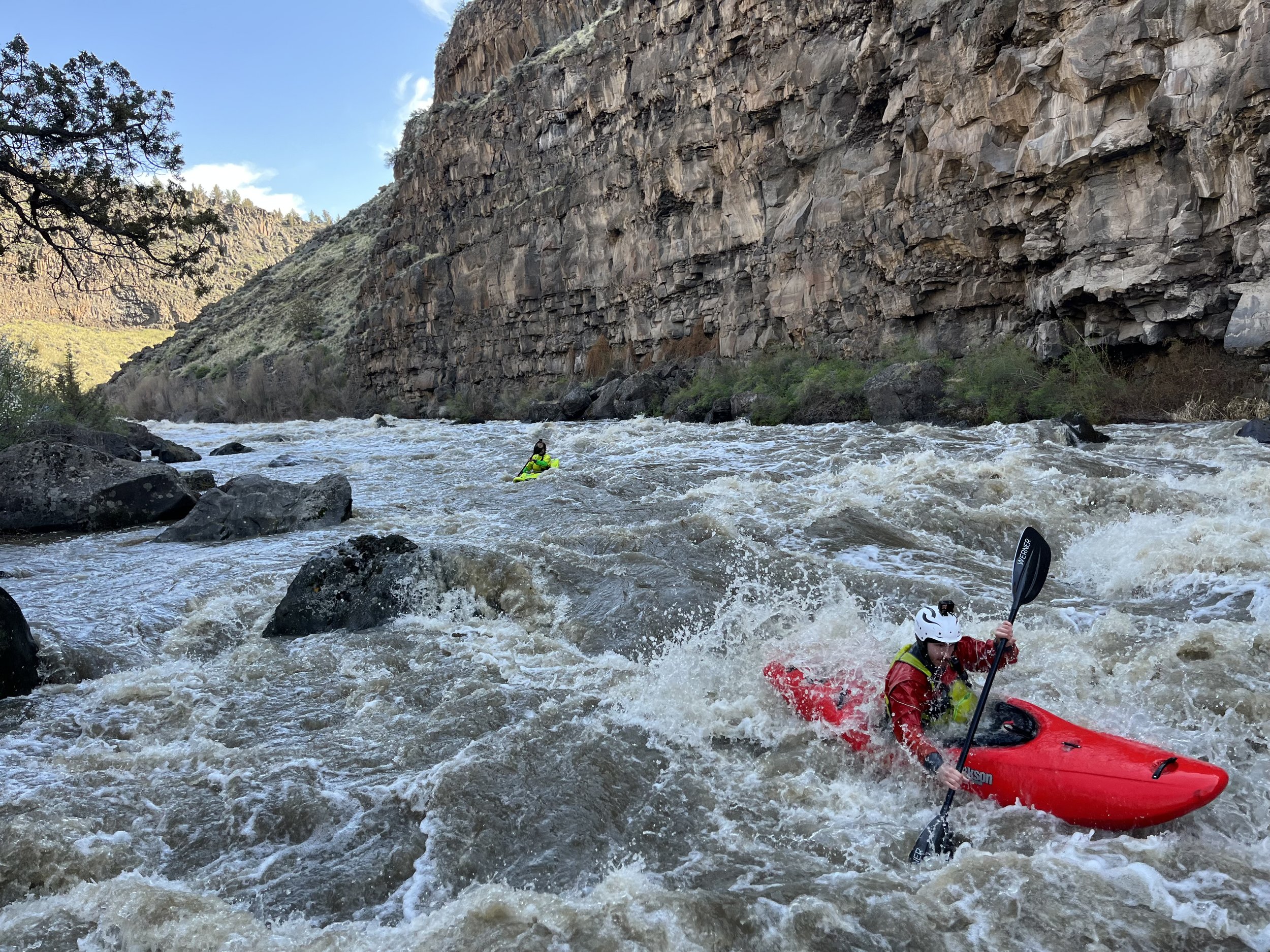Plant a Native Garden
Welcoming wildlife within our urban neighborhoods
By Kristin Reidelberger, Cities and Towns Associate Program Manager, Central Oregon LandWatch
Urban native gardens are certainly not a panacea to global environmental challenges, but they do make a difference locally, and anyone — even beginners with “black thumbs,” renters with only a small balcony and some pots, and homeowners with itty bitty yards — can support local wildlife by planting a native garden.
Honey bee enjoying showy milkweed at Franklin Corner Pollinator Garden. Photo: Barb Rumer
Oh the joy of native gardens
Something that reliably fills me with unbounded joy is the annual reawakening of the earth after a long winter sleep. Properly bundled, I amble through my neighborhood, searching out tiny signs of spring in my neighbors’ gardens — the fresh green tips of hyacinth leaves pushing through the cold soil, and fuzzy buds on woody branches — that are too often passed by unnoticed in our busy lives. Every day has a new unfolding, an opening of a new gift. As soon as the manzanitas begin to bloom, the word is out. The ceanothus and antelope bitterbrush follow right behind, as well as countless wildflowers, shrubs, and trees, stretching their arms and yawning open, as color returns to their cheeks.
As for us humans, we also experience a sort of “reawakening” in spring. We emerge from our homes, and soak up the extra hours of warm sunlight. Through the long, dark winter we are reminded that our homes are our oasis. They’re where we go to rest and unwind, gather with loved ones, and play and explore creative interests. But we forget that our oasis doesn’t start at our doorstep, it starts in the garden. For ourselves, our neighbors, and our non-human neighbors, our yards and gardens provide a refuge from a harsh built environment. They give us a sense of place, connect us with the earth, and bring beauty, biodiversity, and abundant life into our neighborhoods — in every season. Nature isn’t something that’s “out there.” It’s right here, buzzing and twittering and dancing amongst us in our cities.
Our native gardens provide essential food and shelter for the animals that also call the city home, and they provide an opportunity for us to acknowledge that we share this planet. Human development is a significant contributor to habitat, biodiversity, and wildlife population decline worldwide. Other contributors, like the use of pesticides, harmful fertilizers, and monoculture planting, aren't limited to the farming industry — the lawn is the largest irrigated crop in the United States. Alternatively, many property owners, in a well-intentioned effort to reduce water consumption, transition their water- and labor-intensive lawns to lifeless rockscapes.
If you want to support local wildlife (and my garden walk hobby), you can plant a native garden.
The importance of nature in cities
City governments, and urban residents, have a responsibility to support a healthy local ecosystem. Keeping nature nearby in our neighborhoods is a core element of building for a sustainable future through Complete Communities. Central Oregon LandWatch’s Cities and Towns program works to plan and build our cities well, and with intention — which includes supporting abundant nature. One example of this work is our involvement in the formation of the City of Bend’s first tree code.
Biophilic cities prioritize ecological restoration and repair, support biodiversity, and connect us to our geographic region. Many urban challenges, such as urban heat islands and stormwater pollution are mitigated with green infrastructure such as tree canopy, rain gardens, and bioswales. Green infrastructure, including native gardens and forests, is especially critical in a warming climate to build resilience to extreme weather events and to support public health — especially for populations like the young and elderly, those with preexisting health conditions, outdoor workers, and low-income residents. No less important: keeping nature nearby in our cities also provides significant mental health benefits.
Wildlife populations also find themselves vulnerable with rising temperatures, drought, wildfires, and development-driven habitat loss. Our urban neighborhoods can support wildlife, if we provide the right environment. Migrating birds might stop for a snack and a nap in your neighbor’s serviceberry. Our local darling, the mule deer, also permeates city boundaries en route to surrounding rural lands and wild lands beyond, and depends on finding food (rabbitbrush, antelope bitterbrush, and big sagebrush, to name a few) and shade in your neighborhood along the way. Dwindling pollinators may sustain themselves with the help of your garden’s milkweed, penstemon, and water feature on their journey to neighboring food-producing farms.
As a volunteer with Pollinator Pathway Bend, LandWatch member Barb Rumer is keyed into the importance of providing habitat.
“Humans wouldn’t survive without pollinators,” said Rumer, adding, “They are essential for 85% of the world's flowering plants to reproduce. More than 150 food crops depend on pollinators: bees as well as moths, beetles, flies and others. Habitat loss and pesticides are the primary cause of decline.” Her advice: “Help plant a habitat. Keeping a pathway connection between you and others is critical. We need more people planting more native plants. You can smile knowing you are helping.”
Hummingbird in agastache. Photo: Barb Rumer
How you can support wildlife with a native garden
The woes of growing a garden (and growing food) in Central Oregon are no secret. Our arid, high desert climate, with extreme heat and cold, short growing season, and often rocky, sandy, nutrient-poor soils, make it a particularly challenging landscape to cultivate robustness in plants that simply do not want to be here. By choosing plants that evolved over millennia to thrive in this landscape, we spare ourselves from wasteful water use, labor-intensive gardens and lawns, and costly, wishful (and ultimately disappointing) planting.
For Property Owners
Interested in growing a garden, but need some support?
The City of Bend has Turf Replacement Rebate and WaterWise Communities programs designed to support property owners in the transition from water-intensive turf landscapes to more water-efficient, diverse, and native landscapes. Last year, these programs replaced 43,680 square feet of cool season lawns with over 4,000 low water use, climate-appropriate, and native plants—with a collective water savings of 829,920 gallons in just the first year.
For Renters
Don’t have a yard? Here are Barb’s suggestions for small-scale gardening:
“Even people with balconies or decks can help. Many plants can be grown in pots on your deck: Agastache, penstemons, bleeding heart, fleabanes, milkweeds, asters. Keep the pots large enough, have a diversity of plants with a variety of bloom-times and flower types. Plants with tubular flowers attract hummingbirds and bumblebees.”
If pots or windowsill gardens aren’t an option for you, consider reaching out to your landlord or management company to see if they’d shift to low-maintenance native landscaping.
Water use by landscape type. Source: City of Bend
Eight Tips for Starting Your Garden
Shop locally: Visit Wintercreek Nursery for expert advice and a wide selection of native plants, and support local businesses that prioritize sustainable gardening practices.
Use native plants whenever possible, and avoid non-native plants that can disrupt local ecosystems.
Even drought-tolerant native plants need regular watering to get established, so remember to give them big, daily gulps for the first few weeks.
Be sure to include a variety of flowering plants to support a diverse pollinator population
Provide water sources like shallow dishes with rocks, and leave bare ground or small logs for nesting sites. Bug boxes are also a great addition.
Avoid plants treated with neonicotinoids, a harmful class of pesticides, and other chemical pesticides and herbicides that harm wildlife.
Fencing also affects wildlife safety and access, check whether yours is wildlife-friendly
For more info, check out Oregon State University’s step-by-step guide to water-wise gardening.
A bee visiting goldenrod. Photo: Barb Rumer
Planting for a Sustainable Future
Environmental stewardship applies at every scale, and across a variety of actions. Thinking globally and acting locally can be as simple as planting a native garden. It’s a sure way to cultivate joy, and to share that joy with others, knowing you’re making a difference for local wildlife, your neighbors, and your city.







